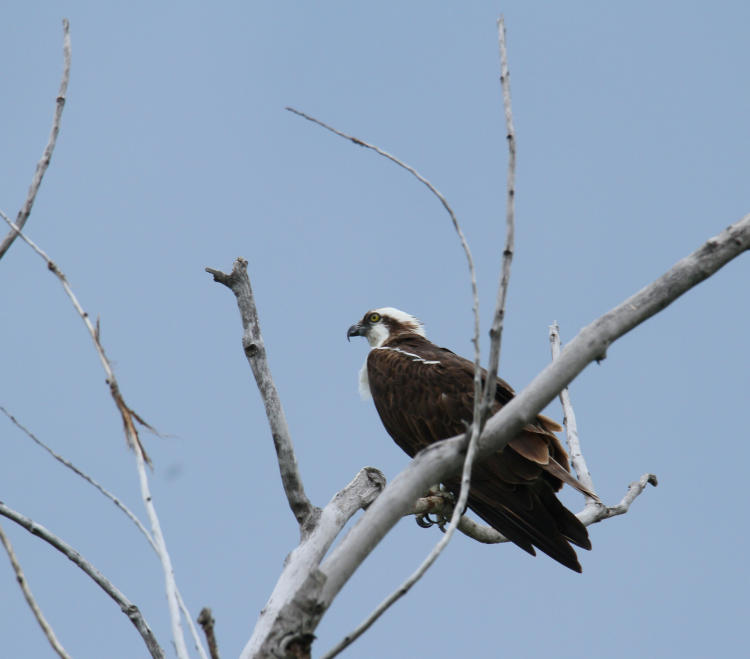
I have a ton of bird photos from the New York leg of the trip to feature, so this seemed to be the best way to break them up; unfortunately, the remaining ones may be a little while in coming, since some obligations are coming up. Right here, we have an osprey (Pandion haliaetus, but you already knew that,) hanging out in a dead tree near the Gatsby mansion as the sky turned foreboding. This is very likely the same one seen wheeling overhead in the storm video, which was taken… well, I don’t know how much later it was taken, because video clips do not have EXIF data and the file tags are all over the place, but none of them are accurate. We’ll just say less than 20 minutes later almost directly underneath this perch.
Like the bald eagles around here at Jordan Lake, the osprey have exploded around Cayuga Lake, at least, partially due to supporting efforts in the area: there are scores of manmade nesting platforms all throughout the region, which I regret not stopping to do a few pics of – most of the time I was on my way someplace when I passed, not able to stop, but laziness plays a role too. I mean, I’d been shooting an active nest with young from a great vantage before I arrived in NY, so my lower angle looking up at nest edges wasn’t comparing, you know?
While touring Montezuma National Wildlife Refuge at one point, an osprey started fishing in a small channel just off the drive, practically hovering in the headwind and providing a very consistent view as I leaned out the window.

No, that’s not enough – let’s go in closer for the details.
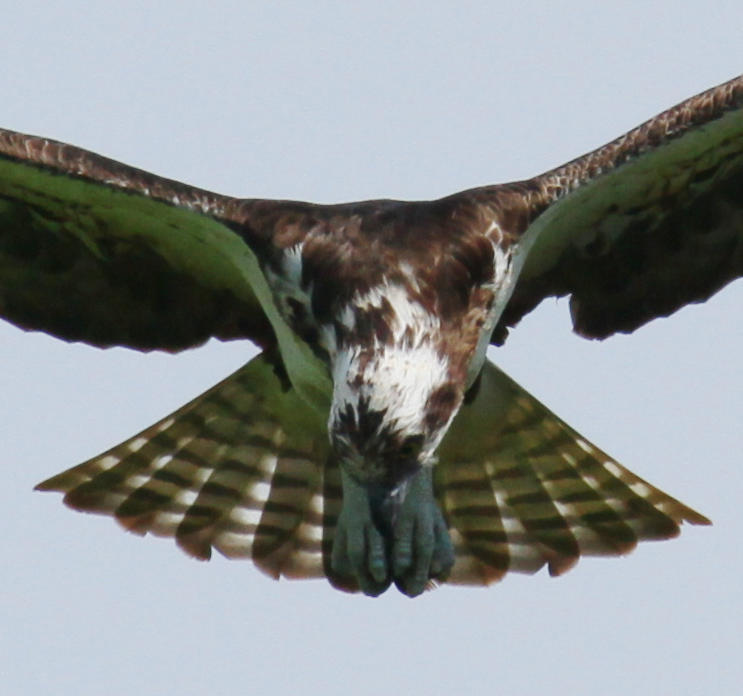
This is a full-resolution crop of the same frame, lightened just slightly to show the eye better, but I want to draw your attention to the color cast of the underside, since that green hue came from the reflection of the marsh grasses alongside the channel. Bear in mind that the bird was 20 meters up, maybe slightly less, but the grasses were extensive and vibrant enough to act as fill lighting in this manner. Cool.
That one never did spot a fish in the brief session nearby, while another one cruised through slowly – again, heading into the wind so it took its time in passing. I snagged a few frames of that one too, including one as it turned to look directly at me.

Varying distance and a little difficulty in pinning down the details sharply enough meant I was trusting autofocus, which was slightly off for this frame – of course. There was nothing else to focus on, but it still seems to twitch a little too much, though the jiggling of the lens and the image stabilizing effects might contribute too. Ah well – better than I was ever getting with the old Sigma 170-500.
As I made my way along, the drive took a sharp bend, and eventually I could look back on a tree that had been ahead of me, finding one of the ospreys (perhaps) had taken a perch and was attempting to be regal, so I did a wide variety of frames for the fartistic, semi-abstract approach.
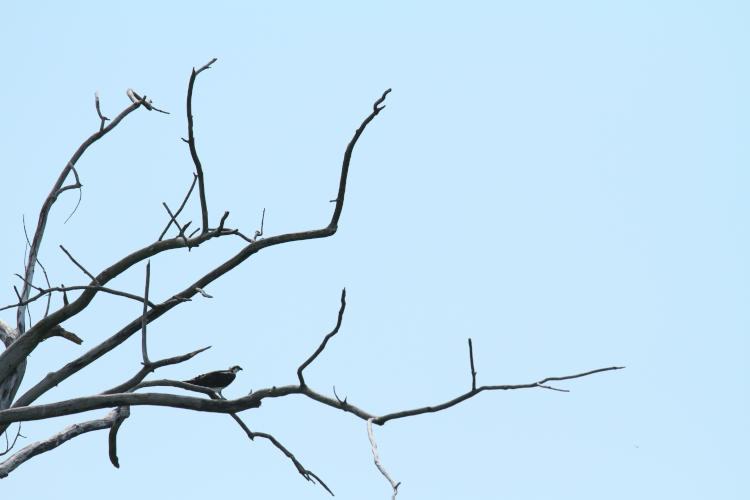
Subjects like this are the kind that I recommend working the hell out of, since it can be presented in countless ways depending on framing and focal length. In fact, I just went back now to look closer at the originals, because it seemed like the bird’s body was aligning with the branch extremely well, but it turns out that the bird is actually behind the branch underneath – technically, further out on the same branch, but falling behind it from our perspective here; other frames show the tailfeathers peeking out from beneath.
And then, we go in closer for the eye contact.
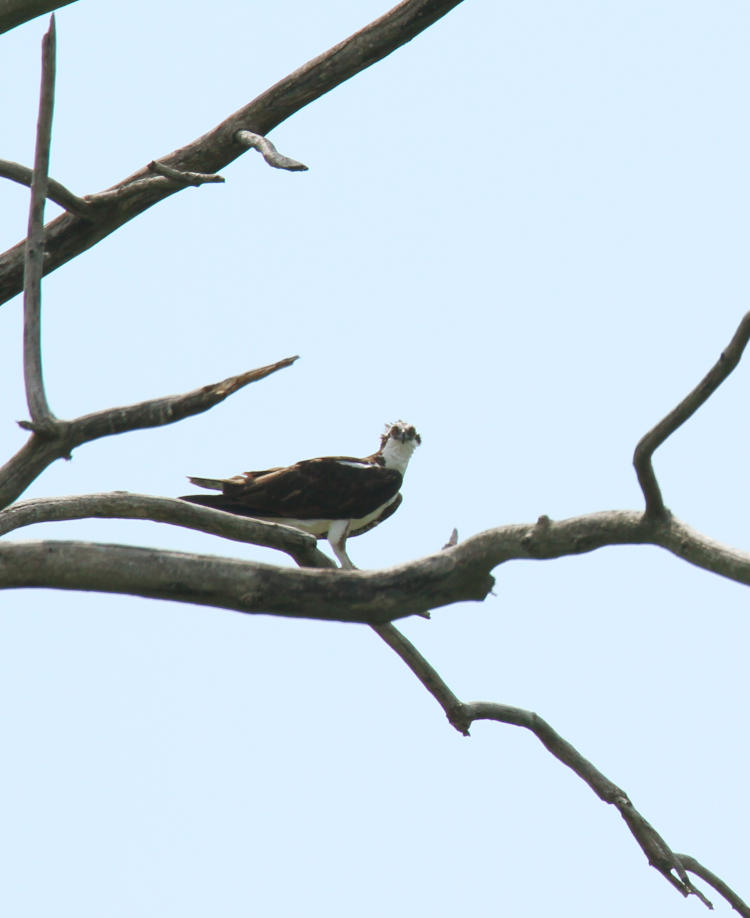
Obviously, it realized I was shooting, and provided this wholly unconvincing grin – ospreys aren’t known for being naturals in front of the camera.
Okay, fine, ospreys cannot grin at all – it’s just a trick of the angle. Happy now? But note the change in background color. The sky was uniformly clear but slightly hazy, and the color change comes solely from the change in shooting angle, this being almost into the sun. Good to pay attention to for the best effect in your scenics.
And now we’ll return to one I teased about, oh, many days ago now.
Out early in the morning at the mansion, I was wandering the lake edge and looking for subjects, knowing there were bald eagles in the area but seeing nothing save a woodpecker. And then, I heard the soft, brief calls of an eagle, almost idle, and very close by – like, within one of the trees on the property. I started a slow stalk of the area, pausing frequently to peer hard into the trees, trying to remain inconspicuous even though I knew I was close enough for easy spotting by anyone, much less eagle-eyed, um, eagles. Unfortunately, I saw an adult fly off as I approached, naturally taking a tack well away from a clear view, but out of curiosity, I maintained my slow approach and concentrated on the region that it had flown from. This suspicion paid off nicely.

That’s a first-year juvenile bald eagle (Haliaeetus leucocephalus) working on a fish, most likely (judging from the age, the calls, and the departing adult) brought to it by that adult, which may indicate that this one really wasn’t long out of the nest. This also fits with the time frame, being late nesting season in NY. This is a cropped frame, but not by a lot; the full frame follows:
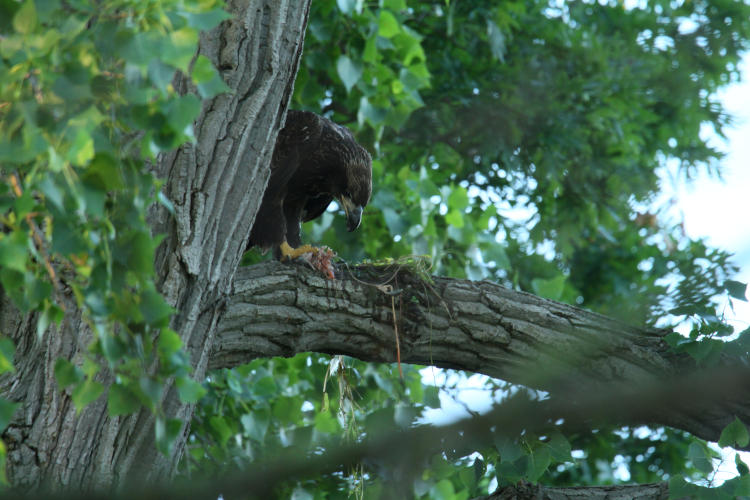
Yes, this is at 600mm, but I was close – if it hadn’t been for the meal, I’m quite sure the eagle would have flown off. I was a good boy and remained where I was, making only slight shifts in position for the clearest view, with no sounds and minimal camera motion. The dampness of the bark is likely where the adult plopped down with the still-dripping fish.
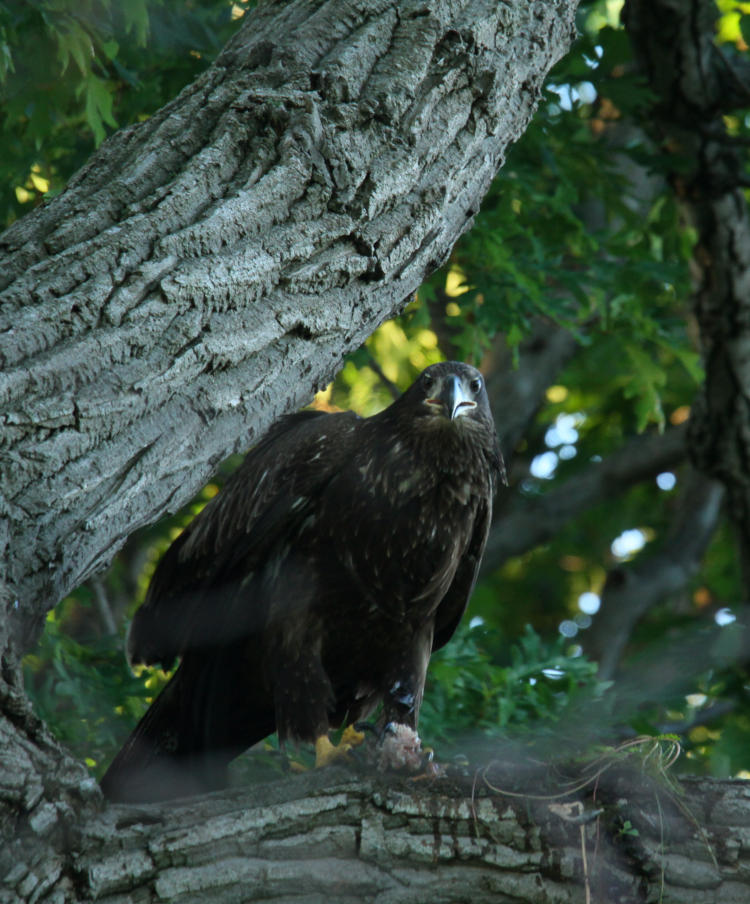
The eagle was most certainly well aware of my presence, but the meal was more captivating. I’ve seen this from several different species: food takes precedent, and it sometimes provides a slight edge in that, if you’ve managed to get close while the bird was intent on a meal, they’ll accept your presence afterward since you behaved yourself. It’s not a hard rule – many species will simply fly off with their food – but it’s worked more than a few times.

And so you know, despite the fact that it’s only a few months old, by the time they leave the nest, most raptors are the size of the parents, so this bird was big. My working distance was roughly 20 meters, maybe a little more, and this guy stood better than half a meter tall – the wingspan would have teased two meters.

After finishing its meal, it hopped a short ways along the branch, and I shifted position more to silhouette it against the sky, showing off the telltale ‘scruffy’ head feathers, lifting up on the neck, that always made me feel that ‘bald’ eagle was a stupid name; you can always see the feathers standing up! The scientific name is a more accurate description, and certainly more PC.
The eagle never flew away while I was there, so I take some credit for being unobtrusive (or perhaps nowhere near big enough for the eagle to feel threatened – take your pick.) I simply moved on once I had more than enough photos to make it worthwhile. A little later on, however, I returned to the spot directly underneath its perch, hoping to find some feathers, even though at this age, it hasn’t had flight feathers long enough to be molting them anyway. But the remains of its meal were evident.
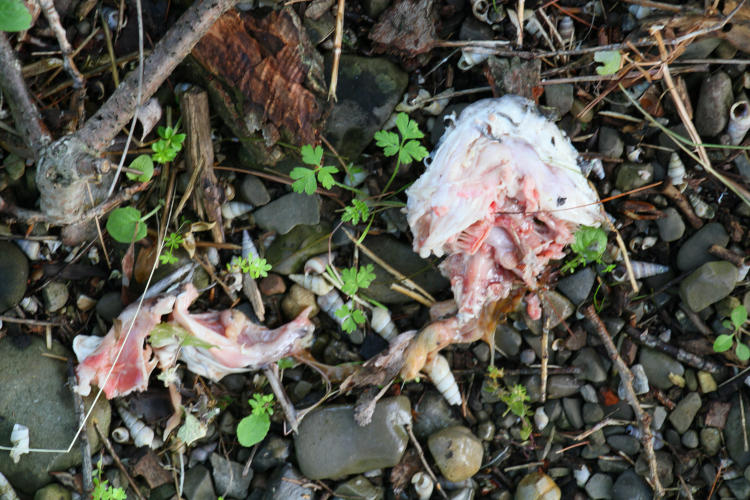
Huh! Back in my day, we ate the entire bullhead! And we were grateful!




















































